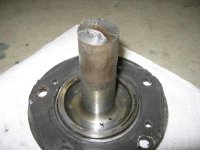Folks,
The clutch on my Austin-Healey 3000 does not seem to engage.
I amposting here and on teh Healey forum for greater exposure to this strange problem.
I pulled out of my garage and everything was fine. The car died while waiting for the garage door to close. When I restarted it and put it back in gear, the car would not move in any gear. I can shift into all gears with the engine running. Under car observations verify that the slave cylinder is working and the rod moves at least 5/8 inch.
With the car on jack stands, I started the engine and let the clutch out in all gears. The rear tires only turn when the transmission is in 4th gear, and they do not seem to be turning very fast. Putting on the brakes with the transmission in 4th gear and the engine running does not reduce the rpm at all.
The clutch can and pressure plate have around 22,000 miles on them. I can’t believe anything is worn out with such low miles, especially when things stopped working all of a sudden.
Any thoughts would be greatly appreciated.
Ron
The clutch on my Austin-Healey 3000 does not seem to engage.
I amposting here and on teh Healey forum for greater exposure to this strange problem.
I pulled out of my garage and everything was fine. The car died while waiting for the garage door to close. When I restarted it and put it back in gear, the car would not move in any gear. I can shift into all gears with the engine running. Under car observations verify that the slave cylinder is working and the rod moves at least 5/8 inch.
With the car on jack stands, I started the engine and let the clutch out in all gears. The rear tires only turn when the transmission is in 4th gear, and they do not seem to be turning very fast. Putting on the brakes with the transmission in 4th gear and the engine running does not reduce the rpm at all.
The clutch can and pressure plate have around 22,000 miles on them. I can’t believe anything is worn out with such low miles, especially when things stopped working all of a sudden.
Any thoughts would be greatly appreciated.
Ron

 Hi Guest!
Hi Guest!

 smilie in place of the real @
smilie in place of the real @
 Pretty Please - add it to our Events forum(s) and add to the calendar! >>
Pretty Please - add it to our Events forum(s) and add to the calendar! >> 



